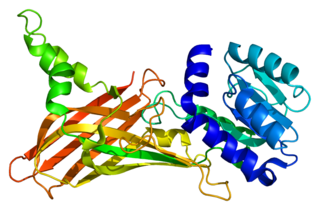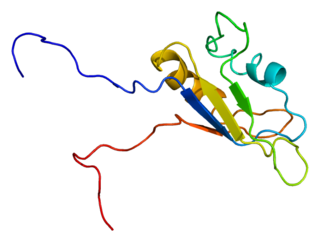RNA-binding protein FUS/TLS (FUsed in Sarcoma/Translocated in LipoSarcoma), also known as heterogeneous nuclear ribonucleoprotein P2 is a protein that in humans is encoded by the FUS gene. [3] [4] [5] [6] [7] [8]
RNA-binding protein FUS/TLS (FUsed in Sarcoma/Translocated in LipoSarcoma), also known as heterogeneous nuclear ribonucleoprotein P2 is a protein that in humans is encoded by the FUS gene. [3] [4] [5] [6] [7] [8]
FUS/TLS was initially identified as a fusion protein (FUS-CHOP) produced as a result of chromosomal translocations in human cancers, especially liposarcomas. [4] [7] In these instances, the promoter and N-terminal part of FUS/TLS is translocated to the C-terminal domain of various DNA-binding transcription factors (e.g. CHOP) conferring a strong transcriptional activation domain onto the fusion proteins. [9] [10]
FUS/TLS was independently identified as the hnRNP P2 protein, a subunit of a complex involved in the maturation of pre-mRNA. [11]
FUS/TLS is a member of the FET protein family that also includes the EWS protein, the TATA-binding protein TBP-associated factor TAFII68/TAF15, and the Drosophila cabeza/SARF protein. [12] [9]
FUS/TLS, EWS and TAF15 have a similar structure, characterised by an N-terminal QGSY-rich region, a highly conserved RNA recognition motif (RRM), multiple R GG repeats, which are extensively demethylated at arginine residues [13] and a C-terminal zinc finger motif. [5] [7] [12] [14]
The N-terminal end of FUS appears to be involved in transcriptional activation, while the C-terminal end is involved in protein and RNA binding. In addition recognition sites for the transcription factors AP2, GCF, Sp1 have been identified in FUS. [15]
Consistently, in vitro studies have shown that FUS/TLS binds RNA, single-stranded DNA and (with lower affinity) double-stranded DNA. [5] [7] [16] [17] [18] [19] The sequence specificity of FUS/TLS binding to RNA or DNA has not been well established; however, using in vitro selection (SELEX), a common GGUG motif has been identified in approximately half of the RNA sequences bound by FUS/TLS. [20] A later proposal was that the GGUG motif is recognised by the zinc finger domain and not the RRM (80). Additionally, FUS/TLS has been found to bind a relatively long region in the 3′ untranslated region (UTR) of the actin-stabilising protein Nd1-L mRNA, suggesting that rather than recognising specific short sequences, FUS/TLS interacts with multiple RNA-binding motifs or recognises secondary conformations. [21] FUS/TLS has also been proposed to bind human telomeric RNA (UUAGGG)4 and single-stranded human telomeric DNA in vitro. [22]
Beyond nucleic acid binding, FUS/TLS was also found to associate with both general and more specialized protein factors to influence the initiation of transcription. [23] Indeed, FUS/TLS interacts with several nuclear receptors. [24] and with gene-specific transcription factors such as Spi-1/PU.1. [25] or NF-κB. [26] It also associates with the general transcriptional machinery and may influence transcription initiation and promoter selection by interacting with RNA polymerase II and the TFIID complex. [27] [28] [29] Recently, FUS/TLS was also shown to repress the transcription of RNAP III genes and to co-immunoprecipitate with TBP and the TFIIIB complex. [30]
FUS appears at sites of DNA damage very rapidly, which suggests that FUS is orchestrating the DNA repair response. [31] The function of FUS in the DNA damage response in neurons involves a direct interaction with histone deacetylase 1 (HDAC1). The recruitment of FUS to double-strand break sites is important for DNA damage response signaling and for repair of DNA damage. [31] FUS loss-of-function results in increased DNA damage in neurons. Mutations in the FUS nuclear localization sequence impairs the poly (ADP-ribose) polymerase (PARP)-dependent DNA damage response. [32] This impairment leads to neurodegeneration and FUS aggregate formation. Such FUS aggregates are a pathological hallmark of the neurodegenerative disease amyotrophic lateral sclerosis (ALS).
FUS gene rearrangement has been implicated in the pathogenesis of myxoid liposarcoma, low-grade fibromyxoid sarcoma, Ewing sarcoma, and a wide range of other malignant and benign tumors (see FET protein family). [33]
In 2009 two separate research groups analysed 26 unrelated families who presented with a type6 ALS phenotype, and found 14 mutations in the FUS gene. [34] [35]
Subsequently, FUS has also emerged as a significant disease protein in a subgroup of frontotemporal dementias (FTDs), previously characterized by immunoreactivity of the inclusion bodies for ubiquitin, but not for TDP-43 or tau with a proportion of the inclusions also containing alpha-internexin (α-internexin) in a further subgroup known as neuronal intermediate filament inclusion disease (NIFID). The disease entities which are now considered subtypes of FTLD-FUS are atypical frontotemporal lobar degeneration with ubiquitinated inclusions (aFTLD-U), NIFID, and basophilic inclusion body disease (BIBD), which together with ALS-FUS comprise the FUS-proteopathies. [36] [37] [38] [39]
Frontotemporal lobar degeneration (FTLD) is the pathological term for the clinical syndrome of frontotemporal dementia (FTD). FTD differs from the more common Alzheimer's dementia in that memory is relatively well preserved; instead, the disease presents with a more temporal-lobe phenotype. Behavioral variant frontotemporal dementia (bvFTD), progressive non-fluent aphasia (PNFA) and semantic dementia (SD) are the three best-characterised clinical presentations. FUS positive FTLD tends to present clinically as a bvFTD but the correlation between underlying pathology and clinical presentation is not perfect.
The toxic mechanism by which mutant FUS causes ALS is currently unclear. It is known that many of the ALS-linked mutations are located in its C-terminal nuclear localisation signal, resulting in it being located in the cytoplasm rather than the nucleus (where wild-type FUS primarily resides). [40] This suggests either a loss of nuclear function, or a toxic gain of cytoplasmic function, is responsible for the development of this type of ALS. Many researchers believe the toxic gain of cytoplasmic function model to be more likely as mouse models that do not express FUS, and therefore have a complete loss of nuclear FUS function, do not develop clear ALS-like symptoms. [41]
FUS has been shown to interact with:

The TATA-binding protein (TBP) is a general transcription factor that binds to a DNA sequence called the TATA box. This DNA sequence is found about 30 base pairs upstream of the transcription start site in some eukaryotic gene promoters.

P300/CBP-associated factor (PCAF), also known as K(lysine) acetyltransferase 2B (KAT2B), is a human gene and transcriptional coactivator associated with p53.

DNA-directed RNA polymerase II subunit RPB3 is an enzyme that in humans is encoded by the POLR2C gene.

DNA-directed RNA polymerases I, II, and III subunit RPABC1 is a protein that in humans is encoded by the POLR2E gene.

Protein arginine N-methyltransferase 1 is an enzyme that in humans is encoded by the PRMT1 gene. The HRMT1L2 gene encodes a protein arginine methyltransferase that functions as a histone methyltransferase specific for histone H4.

Cyclic AMP-dependent transcription factor ATF-1 is a protein that in humans is encoded by the ATF1 gene.

Transformation/transcription domain-associated protein, also known as TRRAP, is a protein that in humans is encoded by the TRRAP gene. TRRAP belongs to the phosphatidylinositol 3-kinase-related kinase protein family.

Histone acetyltransferase KAT2A is an enzyme that in humans is encoded by the KAT2A gene.

RNA-binding protein EWS is a protein that in humans is encoded by the EWSR1 gene on human chromosome 22, specifically 22q12.2. It is one of 3 proteins in the FET protein family.

ERG is an oncogene. ERG is a member of the ETS family of transcription factors. The ERG gene encodes for a protein, also called ERG, that functions as a transcriptional regulator. Genes in the ETS family regulate embryonic development, cell proliferation, differentiation, angiogenesis, inflammation, and apoptosis.

Protein arginine N-methyltransferase 5 is an enzyme that in humans is encoded by the PRMT5 gene. PRMT5 symmetrically dimethylates H2AR3, H4R3, H3R2, and H3R8 in vivo, all of which are linked to a range of transcriptional regulatory events.

Transcription initiation factor TFIID subunit 5 is a protein that in humans is encoded by the TAF5 gene.

Splicing factor, arginine/serine-rich 9, also known as SFRS9, is a human gene encoding an SR protein involved in splice site selection in alternative splicing.

Transcription initiation factor TFIID subunit 11 also known as TAFII28, is a protein that in humans is encoded by the TAF11 gene.

TATA-binding protein-associated factor 2N is a protein that in humans is encoded by the TAF15 gene.

Nuclear transcription factor Y subunit gamma is a protein that in humans is encoded by the NFYC gene.

FUS-interacting serine-arginine-rich protein 1 is a protein that in humans is encoded by the SFRS13A gene.

POZ-, AT hook-, and zinc finger-containing protein 1 is a protein that in humans is encoded by the PATZ1 gene.

Zinc finger protein 143 is a protein that in humans is encoded by the ZNF143 gene.
The arginine-glycine or arginine-glycine-glycine (RG/RGG) motif is a repeating amino acid sequence motif commonly found in RNA-binding proteins (RBPs). RGG regions in proteins are defined as two or more RG/RGG sequences within a stretch of 30 amino acids. Initially named the RGG box, it confers a protein with the ability to bind double-stranded mRNA molecules. The RGG motif has been observed in proteins from at least 12 animal species, including humans.